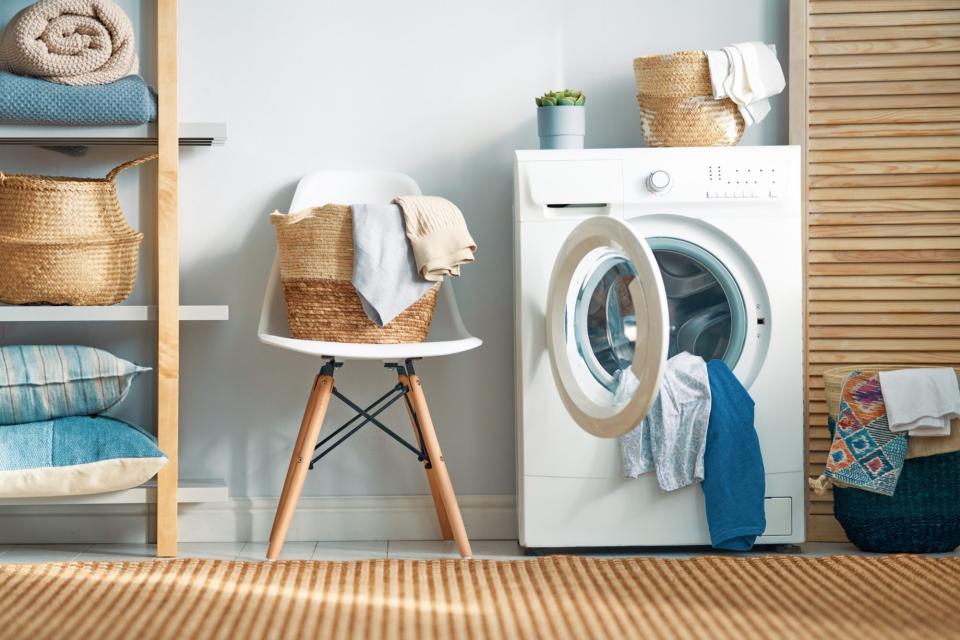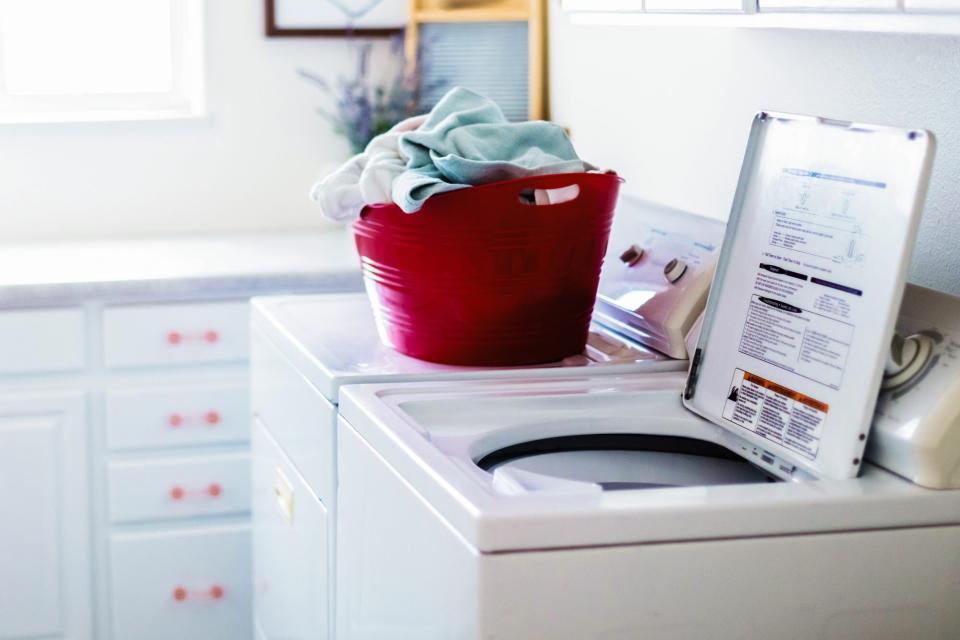The Best Way to Clean Your Washing Machine
TABLE OF CONTENTS
On This Page
Washing Machine Cleaning 101
Getting Started
Cleaning Materials
Top-Loading Washing Machines
Front-Loading Washing Machines
Maintenance
It might seem counterintuitive to regularly clean an appliance you use to clean other items, but it's still important to do—especially when it comes to your washing machine. Over time, this appliance can gather a buildup of debris, resulting in everything from odors to mold. Thankfully, cleaning your washing machine is simple and can be done with both chemical and natural methods (one of which calls on trusty vinegar, which is a great DIY washing machine cleaner!).
Related: 14 Items You Didn't Know You Could Clean in Your Washing Machine

Getty / Choreograph
How Often You Should Clean Your Washing Machine
In an ideal world, you should be cleaning your washing machine about once a month, notes Courtenay Hartford, the author of The Cleaning Ninja. "Cleaning your washer should be viewed as more of a preventative measure than as something that you do to fix a problem once it arises," she says. "If you start to notice that clothes come out not smelling as clean as they should, it's time to clean your machine. You might also notice buildup of various types of debris (pet fur, leaves, etc.) around the seals—that's a visual cue that you might have forgotten to run a good cleaning cycle for the last few months."
Why Regular Cleaning Is Important
Beyond debris, soap residue from your detergent and bath products, as well as minerals from your water, can build up and create an environment for bacteria to grow over time. Not only can this residue eventually clog up the inner workings of your machine, it can also impact how the machine functions; this might mean unpredictable water temperature or transferred odors between clothes.
How to Start Cleaning Your Washing Machine
To begin the cleaning process, wipe out the interior and the seals around the door of the machine with an all-purpose cleaner. For top-loading machines, remove debris from any filters or drains around the seal, explains Hartford. If you have a front-loading washer, identify the drain filter (which should be located behind a small front-facing door near the bottom) and shake it over the trash; rinse it well before replacing it. Have a big bowl handy to catch any excess water that drains out when you remove the cap from the drain tube.
Materials You'll Need
Washing machine cleaner
Vinegar
Baking soda
Microfiber towel
If you're noticing unpleasant odors in your machine or clean clothes, try a washing machine cleaner like Affresh, Hartford says; follow the package instructions.
Use Vinegar as a DIY Washing Machine Cleaner
If you don't want to use a chemical formula, there is another alternative to getting your washing machine clean and odor-free—and you likely already have the solution under your kitchen sink: vinegar, explains Jennifer Parnell, the co-founder of Humble Suds. "The acidity kills bacteria, cuts through grim and build up, and knocks out odors, especially when combined with baking soda," she says.
Check the instructions on your washer's owner manual before attempting this DIY washing machine cleaner, advises Parnell. If you have the all clear, pour 2 cups of vinegar into your detergent dispenser and run your washer on the hot cycle. "When it is complete, add a half-cup of baking soda to the drum and run another hot cycle," she says. After this cycle, seal the deal by spraying the drum's interior with more vinegar (add some to a clean spray bottle to make the process easier) before wiping it down with a microfiber towel. "The vinegar and hot water together are enough to wash away a small amount of soap residue buildup," says Hartford.
Here's the thing: If you're using a non-high efficiency (HE) machine, you're going to need to add more vinegar to the cycle, since they use more water per wash; use double the amount (4 cups) in your non-HE machine, shares Parnell.

GETTY IMAGES
How to Clean a Top-Loading Washing Machine
There are two types of top-loading washing machines: traditional and high-efficiency models, says Jessica Petrino, an appliance expert and editorial director at AJ Madison. Traditional models have an agitator in the center, and high-efficiency, hybrid top loaders have a flat disc-shaped impeller at the bottom.
Follow Petrino's steps to clean both types of top-loading washing machines:
For traditional models, take the agitator apart and soak in the sink with hot water, vinegar, and baking soda.
For hybrid models, detach the impeller and soak in the hot water, vinegar, and baking soda solution. (Since there is typically a bolt that keeps this part in place, Petrino only recommends removing occasionally for a deep-clean.)
"For hybrid models, make sure to clean and inspect the fabric dispenser for unwanted gunk," says Petrino. "It's common to discover buildup of detergent, fabric softener, and residue on any washing machine."
For both types of top loaders, run a hot water cycle and drop in a washing machine cleaning tablet like Oxy Clean or Affresh and follow the instructions on the package. As a natural option, fill the machine with hot water and a vinegar and baking soda mixture. Always reference the brand's recommendations before going the DIY route.
For washers with rubber components or hoses, don't use vinegar; it can cause the hoses to crack and leak over time.

GETTY IMAGES
How to Clean a Front-Loading Washing Machine
Contaminants such as waste from previous washes, as well as from food, residual detergent, dirt and tap water can accumulate in washing machines, including your front-loading one, says a spokesperson at Samsung. "If left unchecked, this waste can foster the growth of up to 14 different germs and 12 different molds in a typical washer," they say. "For a washing machine to be at peak performance, keeping the tub fresh is essential."
Follow these expert-approved steps to clean a front-loading washing machine:
Make sure there is not any laundry in the tub, and remove any remaining water in the tub by running a spin-only cycle.
Pour liquid chlorine bleach into the detergent compartment and fill it to the max line. Note: Don't use the bleach compartment.
After pouring the liquid chlorine bleach, use the "self clean" function. (Do not leave liquid chlorine bleach in your washer.) Close the front-loading washer's lid or door and press the power button.
Select self clean, self clean+, or pure cycle, and then press the start or pause button to start. Self clean time varies from model to model, but is approximately four hours for front-load washers.
When the self-clean cycle completes, wipe clean any residue in the tub using paper towels.
Run a rinse and spin cycle to remove any remaining residue. If necessary, continue running additional cycles until there is no more visible mold residue.
Leave the lid or door open to let the washing machine dry. Also leave the detergent drawer open to help it dry.
Wipe down the pump filer, which is typically located on the front, near the bottom, and behind a panel on front-loading washing machines.
If you notice odor or mold remaining, even after several cleanings, call a professional for service.
How to Maintain a Clean Washing Machine
Going forward, try to keep the door open about an inch between laundry cycles to allow for more airflow; letting the inside of the machine dry out will slow down bacteria growth. Wipe your machine's seals a little more often and clear the filters and drain around the seal, as well, so less of that debris gets swept down into the main drain filter inside your machine. "It's worth noting that a machine that's used regularly—every day or every other day—doesn't give bacteria a chance to grow and create unpleasant odors," says Hartford. "You'll probably find that your problems with smelly laundry will decrease greatly." Now there's one silver lining to doing load after load of laundry.

